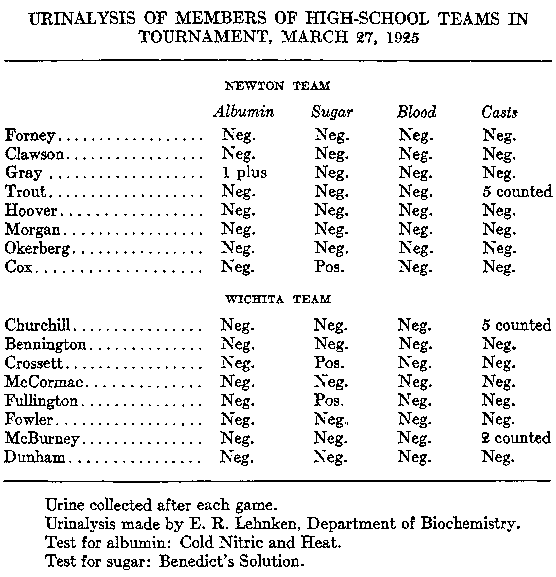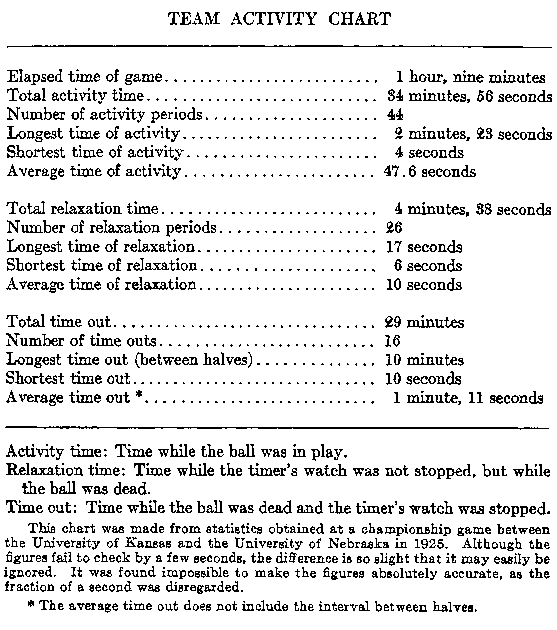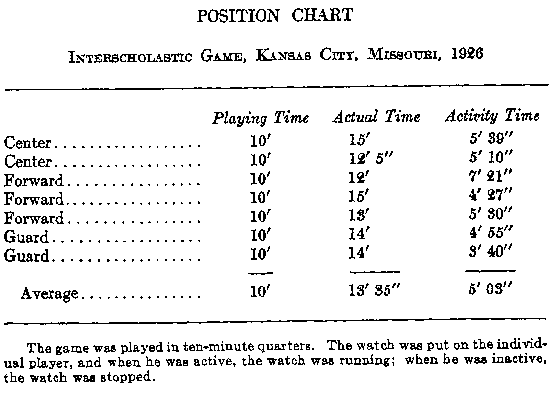|
THERE is a popular
impression, especially among spectators, that basketball is a most
strenuous game. This impression at one time was so strong that many
people felt that basketball was too severe a game to be played by young
people, and especially by girls. The idea that the game is too strenuous
has come largely from people who watch the game. It is only natural that
these people follow the ball constantly and see action wherever the ball
is, judging, therefore, that all the players are constantly in action.
Many have taken the attitude not only that basketball is a strenuous
game, but also that it may be injurious to those who play. I shall show
later that the game is not injurious.
Doctor McCurdy, of
Springfield College, was of the opinion that basketball was too
strenuous, and he decided to conduct experiments to determine its effect
on the players. Examinations were given to the men after a game, and the
results seemed to verify bis belief. Albumin and casts were found in an
astonishing number of cases. Doctor McCurdy-published the findings of
the experiment in his book on the physiology of exercise, and some
people accepted these findings as proof of their contention that the
game was too strenuous.
I read his report, and
I determined that if they were correct and if no other factor had
entered, basketball indeed should be more closely studied. If a majority
of players showed albumin, blood, and casts after playing in one game,
what then would be the effect on the young men that were taking part in
tournaments all over the country? I determined to carry out a series of
experiments under the most severe conditions that I could find.
The opportunity to do
this work presented itself when the State High School Tournament was
played at the University of Kansas. Many teams would take part in this
tournament, and the boys, playing game after game under unnatural
conditions, would show the effects if the game were too strenuous. Mr.
C. E. Rowe, who was a student in the department of physical education at
that time, assisted me in the experiment.
The object of the
experiment was to examine the two teams that would play in the final
game. We wanted a urinalysis of the men on these teams, for we felt that
after having gone through the entire tournament and after having played
in the final game, they would surely indicate any harmful effects. In
order to get a test of these two teams, it was necessary to obtain a
specimen from the players of every team that won. To Mr. Rowe fell the
task, and throughout the four days of play, his work was invaluable.
After hundreds of tests
had been run, we began to realize that our results were going to be
different from those of Doctor McCurdy. Team after team that we examined
showed little or no abnormal condition, and it soon appeared that we
were to upset some of the fixed ideas about the strenuousness of
basketball.
When it became evident
that our results were radically different, I was afraid that there might
be a feeling that the results were not exactly fair because of my
relationship to the game. With this thought in mind, I turned over the
specimens to the department of physiological chemistry in the
University. The findings of these experts so closely coincided with my
own that I was assured that our work was authentic and that the findings
might be published. The results of the experiment appeared in the guide
for 1925, and they had much to do with dispelling the belief that
basketball was an exceptionally strenuous game.
In spite of the tests
that I had made, some persons still felt that tournament play might be
harmful. Indiana, one of the leading states in basketball, decided to
carry on experiments similar to mine at its state tournament. A group of
doctors was selected to make the tests under the most critical
conditions. The findings of this group definitely settled the fact that
basketball in itself is not in any way a harmful game.
The tests we made were
the same that were used in life insurance examinations. Both the cold
nitric and the heat tests were used for albumin, and if either of these
showed the slightest trace, the case was considered positive. Benedictís
solution was used for the sugar tests, and the slightest signs were
given preference.
Some time before,
LaGrange had made an experiment in which he found an excessive amount of
urea in untrained persons after they had indulged in severe exercise. To
check this result, we also included a test for urea. The Doremus
ureometer was used, and after several hundreds of tests had been made
without confirming LaGrangeís findings, we decided to discontinue this
phase of the experiment.
The examination for
blood casts was made after the final game only. We decided that the
maximum of strain would be shown in the final game, after

both teams had gone
through the entire tournament. The results of the experiment are shown
in the accompanying chart, and a record of the actual tests that were
made in the urinalysis may be found in the appendix.
As the results of our
experiment had differed radically from those of the earlier experiments,
I sought explanation for these differences. After much study, I came to
the following conclusions:
1. That youth is not so
seriously affected by physical activity as the adult.
2. That the mature
students were so drilled that they could push themselves in both their
practice and their games more than the younger players.
3. That the amount of
food eaten and the amount of outside work done might aid in the
production of albumin.
4. That high-school
players were cared for, they were put to bed and rested between games,
their diet was carefully selected, and their sleep was carefully
prescribed.
5. That Hillís
investigation on muscle recovery offered another solution.
Hillís investigation
showed that the waste products of muscular activity are restored, to be
again used in energy-producing materials. Lactic acid, which is produced
in muscle activity, will, during the resting period, be resynthesized
into glycogen in the muscle, itself, without being thrown out and new
glycogen being introduced into the body. Under these conditions, the
rest between the games allows the body to recover entirely.
Gould makes the
statement that complete recovery from strenuous activity may be
consummated in one and a half hours of rest.
It is possible that any
one, or a combination, of all of the foregoing factors may explain the
differences in the results of the various experiments.
I have said that many
people thought that the players were in constant motion during a
basketball game. In reality, there are few games, indeed, in which
players are in constant action.
In gathering the
statistics for the foregoing statements, we observed a series of games
of the Interscholastic League of Kansas City, Missouri, through the
seasons of 1925, 1926, and 1927, and at the University of Kansas during
1931 and 1932. We used stop watches to keep track of the time when the
teams were in action, relaxation, and rest. We took not only the
activity time of the teams but also the average activity time for
different positions. Sometimes the player time ran as low as 30 per
cent, as in the position of the guards.
A chart of the division
of time in a championship game at the University of Kansas clearly shows
the amount of rest and relaxation in comparison with the amount of
activity.
The statistics for the
activity of different players were taken at games played in the
Interscholastic
League of Kansas City,
Missouri. The accompanying chart shows the division of time for
high-school players in their different positions.

When we realize that
there are many factors that may affect the playing time of the
participants, it is easy to see that basketball is not so strenuous as
some people have
imagined it to be. A player may be on the floor through a whole game,
but such an instance is the exception rather than the rule. It is common
to see as many as eight or ten substitutions

during a game, and
frequently I have seen whole new teams take the floor. All of these
circumstances tend to cut down even further the activity time of the
individual player. With the true conditions shown, I can see no reason
for anyoneís objecting to the game of basketball as too strenuous.
Basketball, in my
opinion, is one of the few team games that emphasizes agility, speed,
and accuracy, and is directly opposed to bodily contact. There is no
necessity for the bodily shock that is part of football, hockey, and
some of the other games.
It is true that, in
certain parts of the country, this contact game is somewhat in vogue,
and there is little doubt that this type of game is more strenuous than
the open free game that is played in many sections. The style of game
largely depends upon the coaches and the officials who work the game. If
the rules are interpreted as they are meant to be, I believe that I
could recommend basketball for any normal boy or girl. |
